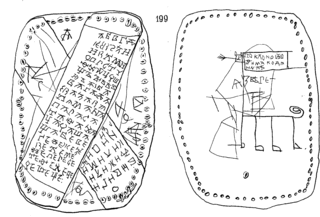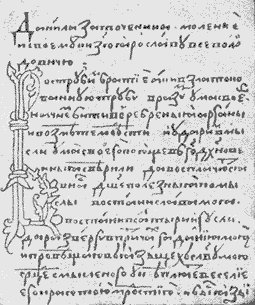 W
WOld East Slavic was a language used during the 10th–15th centuries by East Slavs in Kievan Rus' and its successor states, from which the Belarusian, Russian, Rusyn, and Ukrainian languages later evolved.
 W
WChurch Statute of Prince Volodimir is a source of church law in Old Rus', defined legal authority of church and legal status of clergy by the state: prince (knyaz) and his administration. Vladimir's Statute was a short legal code, regulated relationship between the church and the state, including demarcation of jurisdiction between church and princely courts, and defined index of persons and organizations within the church jurisdiction. The church also got under its supervision the system of weights and measures, and monthly support: tithe from all princely income. The statute was written at the beginning of the 12th century and remade during many centuries. The statute was written in Old Church Slavonic and Old Russian. It was one of the first church sources of Old Russian Law. Church Statute of Prince Yaroslav and other Old Russian princely statutes served to closely purposes. One of the sources of the statute was Byzantine law, including Nomocanon.
 W
WChurch Statute of Prince Yaroslav is a source of church law in Old Rus', defined legal authority of church by the prince (knyaz), his administration and churchmen. Yaroslav's Statute was a short legal code, regulated relationship between the church and the state, including demarcation of jurisdiction between church and princely courts, index of persons within the church jurisdiction, rules of family law and sanctions against moral violation. The statute was written at the 11th–12th century and remade during 13th–16th centuries, in Old Church Slavonic and Old Russian. It was one of the first church sources of Old Russian Law. Church Statute of Prince Vladimir and other Old Russian princely statutes served to closely purposes. But church jurisdiction was expanded in comparison with Vladimir's Statute. A part of the lawsuits in the Yaroslav's Statute was referred to the church jurisdiction, and a part - to joint jurisdiction of the church and the prince. One of the sources of the statute was Byzantine law, including Nomocanon.
 W
WKórmchaia Book or Books of the Pilot or Pidalion or Nomocanon are collections of church and secular law, which constituted guide books for the management of the church and for the church court of Orthodox Slavic countries and are transmission of several old texts. It were written in Old Church Slavonic and Old Russian.
 W
WThis is a list of Latvian words borrowed from Old East Slavic during 8th–13th centuries.
 W
WMerílo Právednoye or Just Measure is Old Russian legal collection of the end of the 13th or the beginning of the 14th century, preserved in the copies of the 14th to the 16th centuries. The name was given in the modern literature, it was taken from the first words of this text: "this books is just measure, true weighing...". Just Measure was written in Old Church Slavonic and Old Russian.
 W
WOnfim was a boy who lived in Novgorod in the 13th century, sometime around 1220 or 1260. He left his notes and homework exercises scratched in soft birch bark (beresta) which was preserved in the clay soil of Novgorod. Onfim, who was most likely six or seven at the time, wrote in Old Novgorodian; besides letters and syllables, he drew "battle scenes and drawings of himself and his teacher".
 W
WPravosudiye Mitropolichye, lit. Metropolitan's Justice) is a source of Old Russian law. It reflects the influence of the secular norms on Old Russian church law.
 W
WThe Prayer of Daniil Zatochnik, also translated as The Supplication of Daniel the Exile or Praying of Daniel the Immured, is an Old East Slavic text created by the Pereyaslavl-born writer Daniil Zatochnik during the 13th century.
 W
WThe Tale of Igor's Campaign is an anonymous epic poem written in the Old East Slavic language. The title is occasionally translated as The Tale of the Campaign of Igor, The Song of Igor's Campaign, The Lay of Igor's Campaign, The Lay of the Host of Igor, and The Lay of the Warfare Waged by Igor.
 W
WThe Zakón Súdnyi Liúdem is the oldest preserved Slavic legal text. Its source was Byzantine law and it was written in Old Church Slavonic in the late ninth or early tenth century.